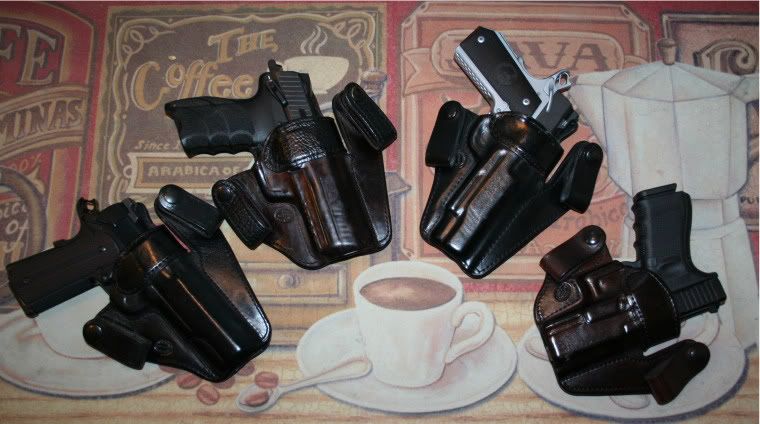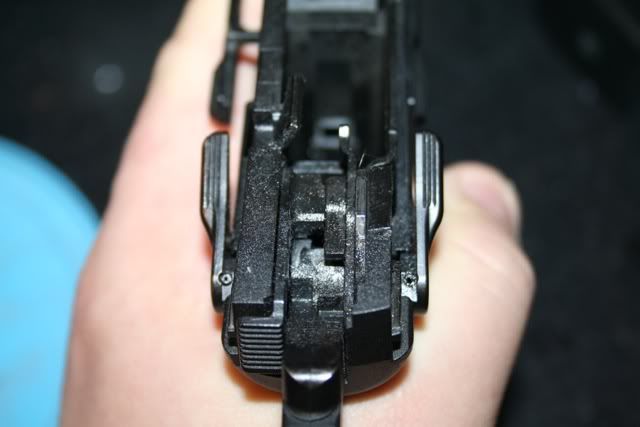I am a die-hard 1911 fan and have no illusions that I am done with 1911s by any means and the addition of this feature on the P30 is very appealing as I can maintain familiarity with the drawing/firing process of a C&L platform. I've been very happy with the HK45 and the addition of the P30S will allow to to shoot more for less $$$, with the cost difference between 9mm and .45, I have the cost of the gun in just a few 1K ammo orders.
I've only got a couple hundred rounds through the gun so far, but plan on running the gun in this years trip to TDI's Partner Tactics Course (another advantage of the P30S is that we don't have to order two calibers of ammunition and can stick with 9mm as the wife will be running her Glock 19) as well as some other classes and of course, IDPA. As such, I'm not going to talk about two or three hundred "flawless rounds" as I should very well hope that a gun can go three hundred +/- rounds without hiccup.
So what I cam going to talk about is what I like/dislike about the P30S.
Some may be wondering why I chose the regular length P30S instead of the P30LS, well I'm a big proponent of keeping varying carry platforms and methods as close together as possible, and my preferred carry holster is the Milt Sparks Versa-Max II which is/was not available for the P30L...so yes, I actually chose my gun in part due to holster availability but it beats buying a gun and then not being able to find a holster for it. I know without a doubt that I like the VMII, most of my primary carry guns have ridden in one so why change?
 | |||||
| From left to right: Les Baer SRP, HK45, Nighthawk Talon-Recon, Glock 19 |
 |
| Stock Photo from HK USA Website, P30 LEM shown |
A nice feature of the P30 family is that the decocker is not operated by a frame mounted lever like the USP line, it took the de-cocker location of the P2000 and is a button located to the left of the hammer. What this means to us that use the P30S is a C&L manner, is that we don't have to worry about de-cocking the hammer by mashing down too hard on the safety lever.
 |
| Stock Photo from HK USA Website: HK P30S |
**Edited to add: I also like that there is a "detent ball" of sorts under the left side safety lever (will add pics later) that makes the safety much more positive in it's engagement than the the USP or HK45. One other issue, is that when carried C&L, there is a cavernous amount of open space for dirt, lint, etc. to build up in the hammer & sear components..
As much as I like the operation of the de-cocker, one issue I can see happening is that while drawing or re-holstering using the "thumb cap" method that the de-cocker may be actuated and one may end up with a double action first shot when expecting a single action first shot. This will be something that I watch for and will report back later with my findings.
The gun itself is just slightly larger than the Glock 19 which is pretty much the quintessential concealed carry gun, and for me this is good as the grip on the Glock 19 is just a hair too short for my liking and the P30 is just the right size. Despite having a sub 4" barrel, the pistol is quite accurate and like most guns, is more than accurate enough for defense and competition purposes. The one issue I have with the gun is HK's choice of sights, like the HK45, the P30S has the "luminous" sights and I personally find the three-dot arrangement too busy and will be replacing the rear sight in "6-8 weeks" with some newly produced 10-8 rear sights (not yet released but coming soon) to hopefully get a less busy sight picture.
The reset of the gun is a little longer than I'm used too, but by no means intolerable. A trip out for some action work may be in the gun's future, but as of right now I'm OK with it as is.
Additional Pictures:
 |
| De-cocker location, note "cavernous" space inside hammer channel area |
 |
| Additional view of lint trap. |
 |
| Metal safety levers, each pinned to hammer axle |
 |
| Thumb safety, note discoloration and detent |
Excellent review. thank you for taking the time to do it.
ReplyDelete